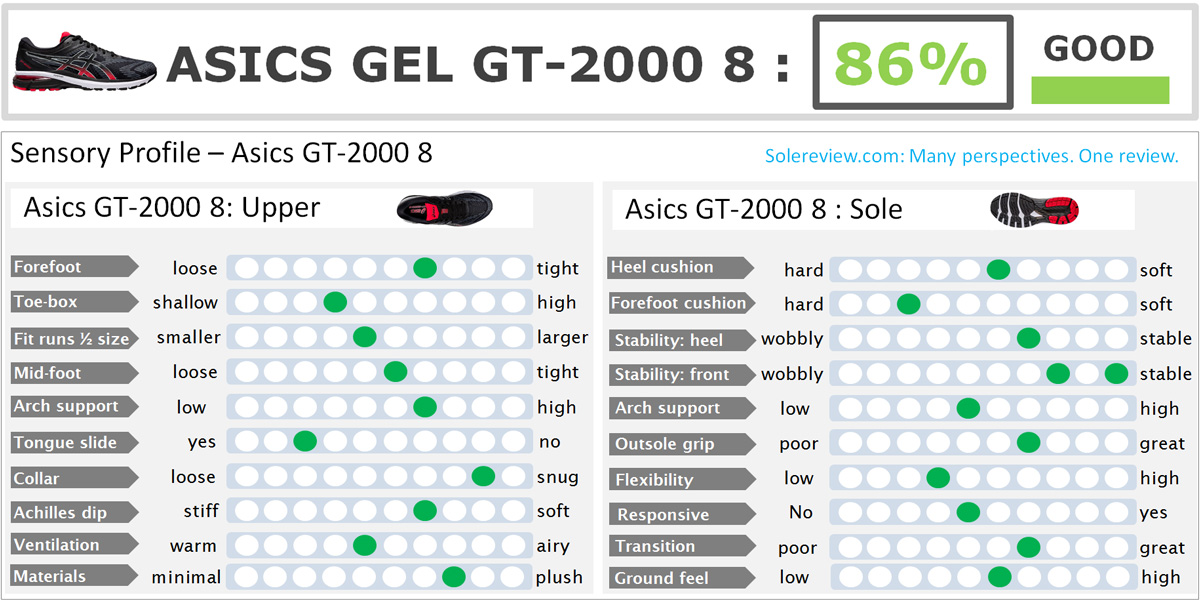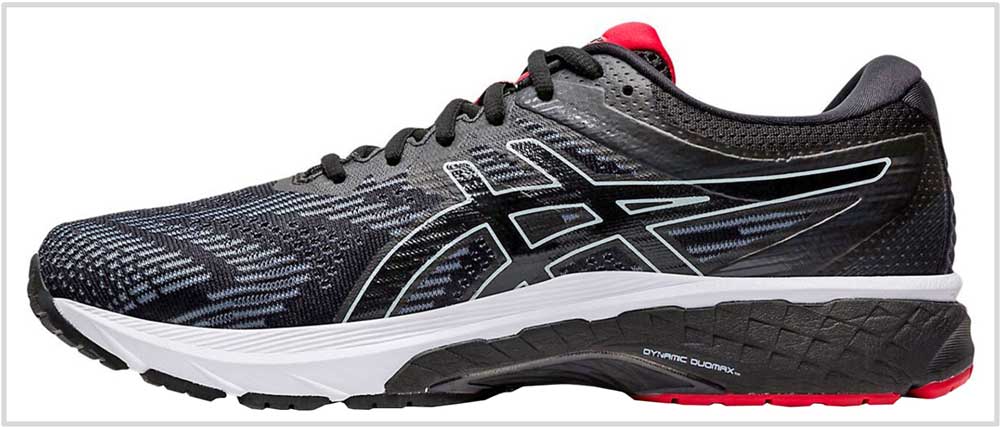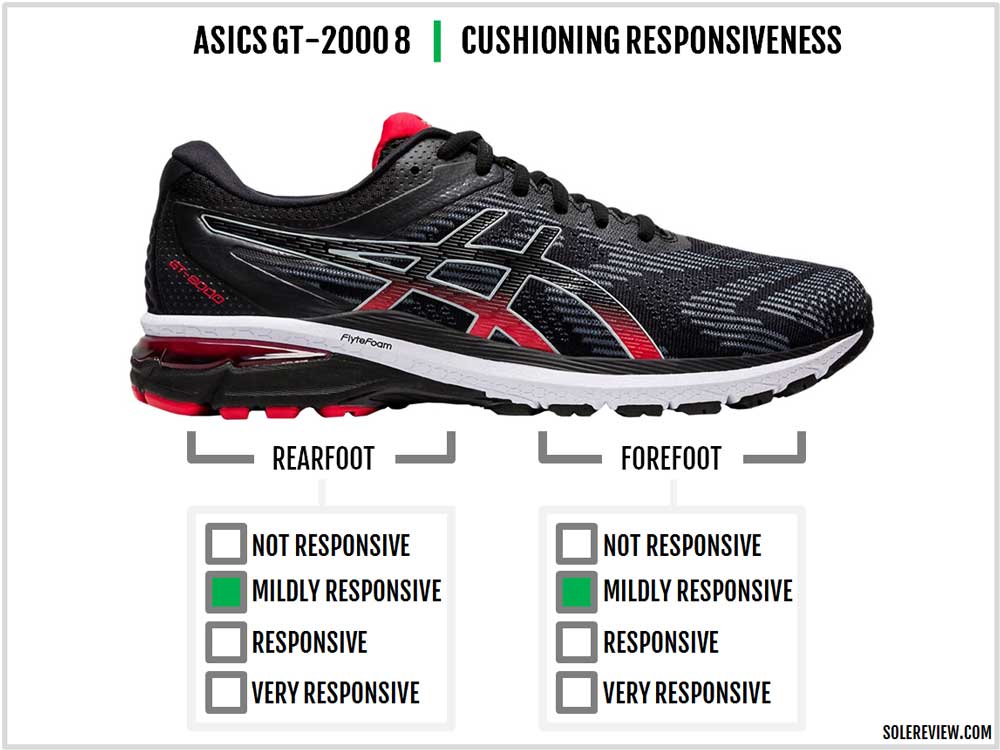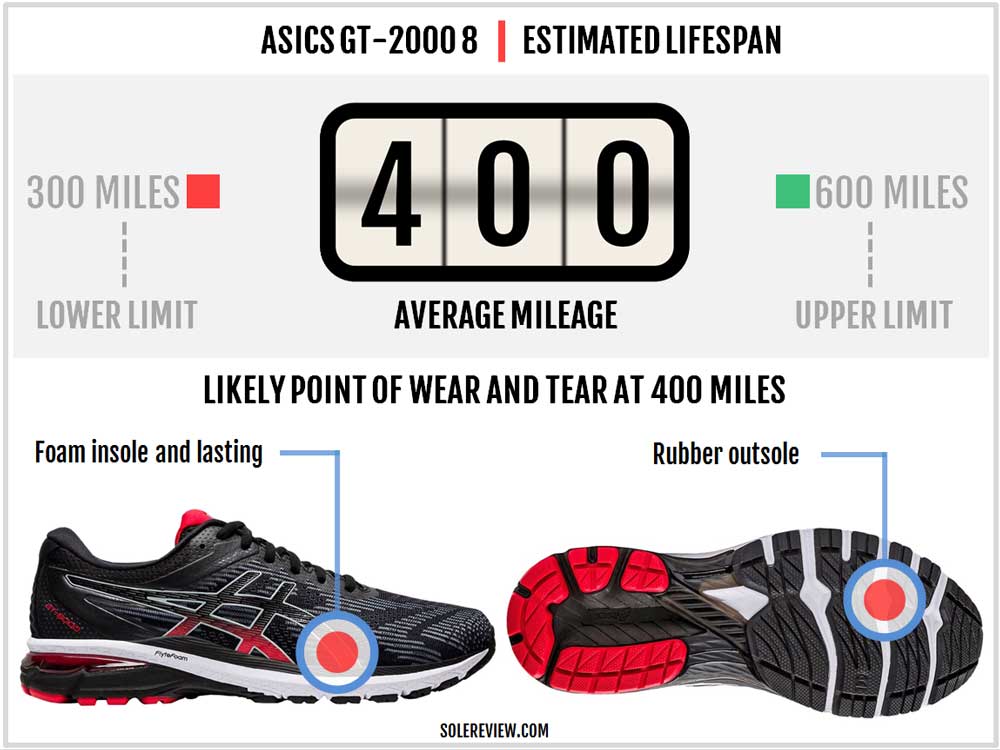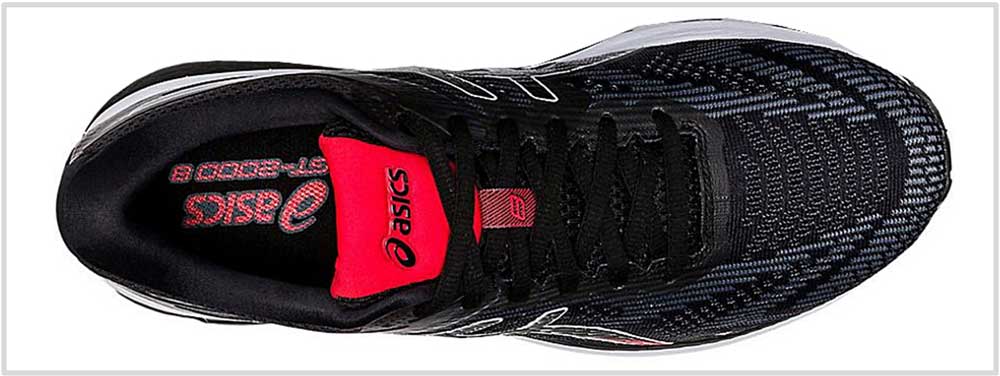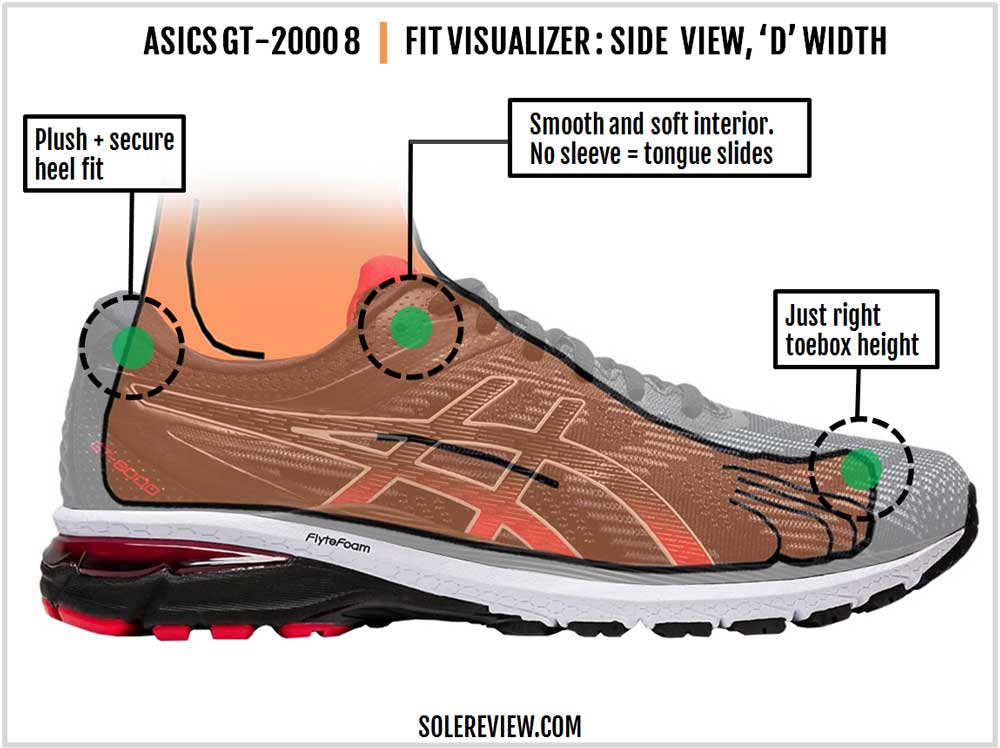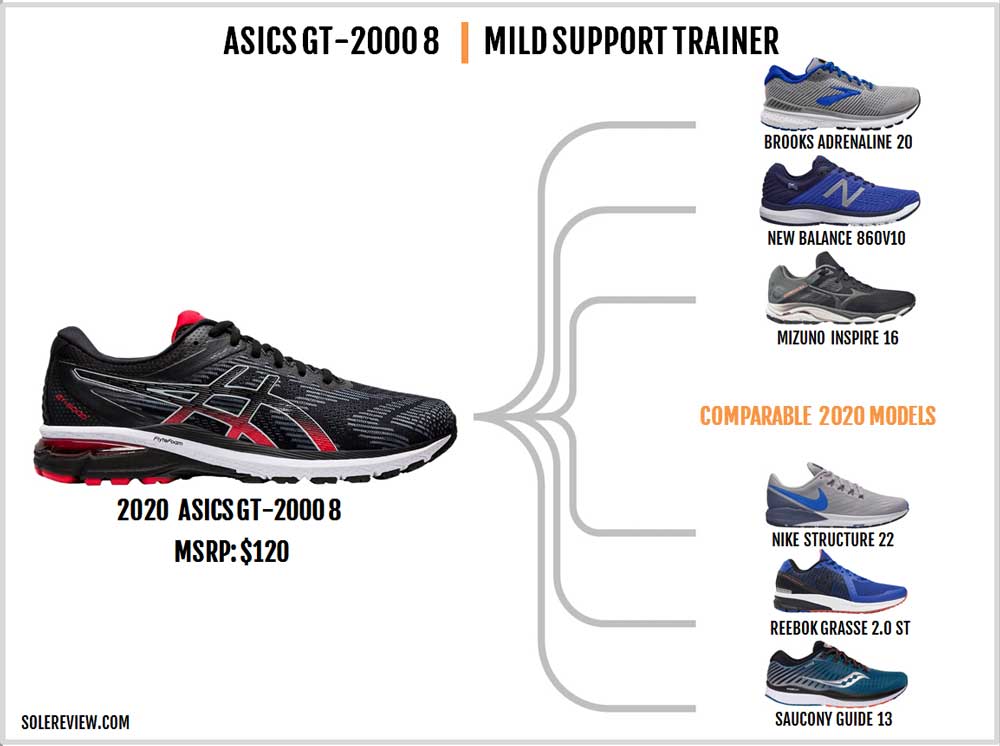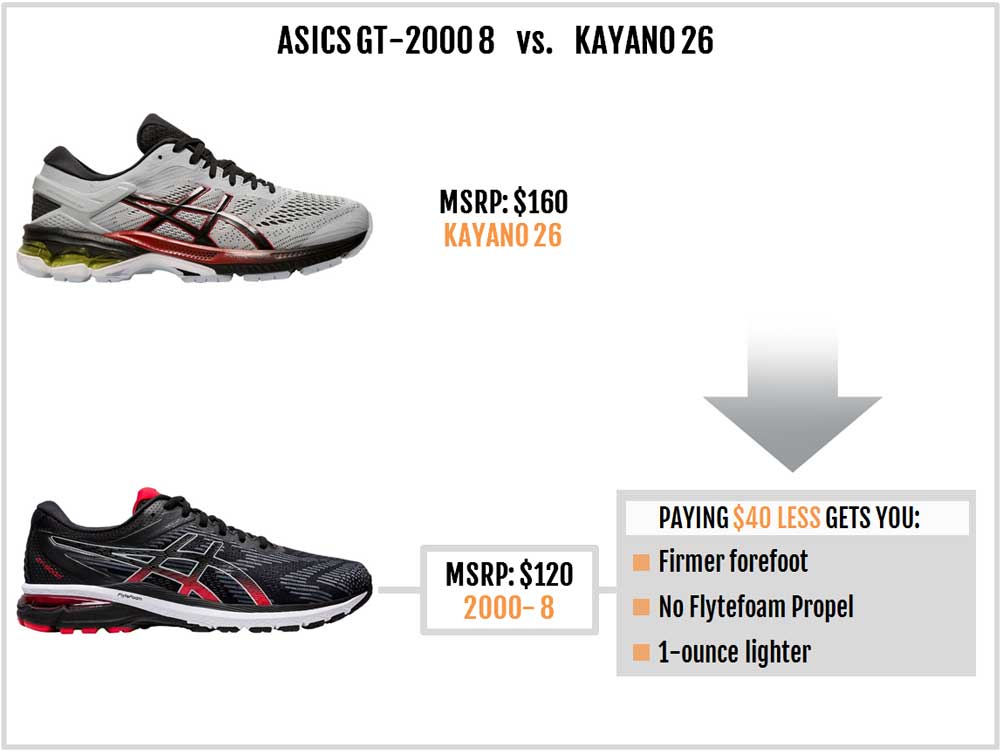INTRODUCTION
At times, an encounter with sameness is oddly reassuring.
Though the Asics GT 2000 8 is firmly anchored in the past, it is a sight for sore eyes. The GT-2000 8 is a far cry from the hyper-light running shoes with their leading-edge cushioning systems.
With this shoe, you’re stepping into a familiar place and time.
A time when running shoes with firmer medial posts were still a regular fixture in sporting goods stores. ‘Stability’ shoes were designed with a harder inner midsole to slow down foot-roll, and the GT-2000 8 happened to be one of the many.
Even if you’ve never spent money on motion-control shoes before, you must have come across names like the Asics Kayano, Brooks Adrenaline, New Balance 860, or the Nike Structure.
The only difference is that while most of the industry has the outgrown traditional stability concept, the Asics GT 2000 remains entrenched in the medial-posted territory.
And we aren’t dissing the shoe. One knows exactly what to expect – more so when the GT 2000 only takes baby evolutionary steps every year.
Like the others before it, the 8th version has a firmer DuoMax foam section along with a visible-Gel window on the outer midsole.
This isn’t saying that the GT-2000 8 hasn’t changed; both the midsole and upper receives updates that are worth discussing. And that’s what this review is about.
Before we get to the nuts and bolts of the GT-2000 8, you should know that there are multiple variants of this model.
Along with the standard engineered mesh version (reviewed), Asics sells a knit GT 2000, trail, waterproof Gore-Tex, and reflective Lite-show variants. Asics has kept the retail price the same across the line so you can choose a GT-2000 of your liking without having to pay a premium.
The Women’s version is identical to the men’s model except for the base upper width (B versus a D) and a 1 mm lower midsole height.
ASICS GT-2000 8 vs. GT-2000 7
Though the GT-2000 8 updates do not drastically alter the overall ride and fit character, the functional difference is going to be noticed by runners.
The forefoot is now 100% Flytefoam instead of a 50:50 split. This is a marked change from the 2000-7’s dual-density forefoot, and this update makes the forefoot firmer and stiffer. The redesign also helps the new GT shed a half-ounce of weight.
Also, the forefoot outsole gets rid of the ‘Guidance Line’. On the 2020 GT-2000, the outsole lugs no longer have the bidirectional flex grooves.
What you get are larger lugs with traditional flex grooves. The older design with the generously-spaced lugs tended to apply pressure, so the redesigned outsole is a welcome change.
The changes made to the rear result in a different cushioning outcome. The stack ratio favors the softer non-Flytefoam crash pad, so the rearfoot is softer. The visible Gel windows are also larger than the 7, so that bumps up the overall softness. The heel offset stays constant at 10 mm.
The GT2K-8’s upper receives several improvements. Replacing the mono-layered mesh of the 2000-7 is a soft, dual-layered textile. The inner midsole gets an Asics logo for structural support and aesthetic detail – something that was previously lacking.
The heel plushness gets a boost. There’s more foam packed inside the soft collar, and that’s also accompanied by a softer tongue flap. As always, there’s no sleeve holding the latter, so there’s some tongue slide during runs.
THE RIDE EXPERIENCE
Some things haven’t changed on the GT-2000 8.
A firmer medial-post – or ‘DuoMax’ in Asics-speak – continues to be a part of the midsole. And it behaves similarly too. It doesn’t feel invasive or press into the arch. It just makes the inner midsole firmer, that’s all.
The visible Asics ‘Gel’ window occupies a lot of real estate in the back. It’s larger than the GT-2000 7, and that’s partly the reason behind the softer rearfoot cushioning. There’s a bit of a bias favoring the Gel side of the midsole, but it’s within acceptable tolerances.
Just like the past few GT’s, there’s a lot of the resilient Flytefoam in the midsole. Even the plastic midfoot shank is untouched – except for the redesigned shape, that is.
And yet, the tweaks introduced on the new GT ends up affecting the ride quality.
The forefoot is a good place to start. The GT-2000 8 takes the Nimbus 21’s lead and makes the front midsole 100% Flytefoam instead of sharing the stack with the softer EVA foam. Unsurprisingly, the forefoot becomes firmer, stiffer, and has better stability than before.
This is also a good opportunity to highlight the changes made to the outsole. Just like the Nimbus 21 (and the 22), the ‘Guidance Line’ no longer splits the blown rubber forefoot into multiple sections.
Instead, you have larger slabs divided by wide side-to-side grooves. Hence, you no longer have to worry about the slabs applying pressure from beneath – as was the case with some of the past models.
But don’t expect the Guidance line to go away. As a matter of fact, the new Cumulus 22 has a full-length Guidance line, the forefoot included. So there is a possibility of the Guidance Line returning on the GT-2000 9 or V10.
There are many benefits of a firm forefoot. The shoe feels quicker, more stable, and easy to transition through. Among the negatives are a less comfortable ride and a longer break-in period.
The GT-2000 8’s overall stability is superior to the 7. Sure, the firmer forefoot helps, but the midsole also acquires raised sidewalls that cup either side of the foot. Even the Kayano 26 had this feature, so it made sense for the GT-2000 to follow suit.
The situation is slightly different in the back. There’s less Flytefoam and more of the softer foam. The Gel windows are also larger than before. Combine all three, and you have a softer ride than the 7. The Women’s GT is mentioned as having a 1 mm lower stack but that makes no difference in real-world terms.
And like all running shoes that have a noticeable difference between the forefoot and rearfoot densities, the ride experience will vary depending on the footstrike.
Rearfoot strikers will the landings relatively soft and gentle. Conversely, runners who land mid/forefoot first will experience the previously described firmness.
There’s a concealed Gel pad inside the forefoot but its small size doesn’t influence the ride at all. The removable, compression-molded insole adds some softness but that’s mostly of a superficial kind. Springiness is absent on the GT-2000; in lieu, there’s better ground feedback from the forefoot.
The transitions aren’t as sorted as the GT-2000 7 due to the relatively softer rearfoot. Not that it matters a lot for a shoe that weighs 10-ounces, but for whatever it’s worth, the split personality of the midsole is noticeable.
Daily training is a suitable use-case for the GT-2000 8. Its firm ride makes it supportive, and there’s enough midsole to keep long runs from punishing your feet.
And the 10-ounce build isn’t bad at all – even the Nike React Infinity Run weighs more than that.
Though the GT-2000 is a stability shoe with a medial post, you don’t have to rotate it with shoes from the same sub-category.
That said, low-profile trainers like the Asics DS-Trainer 25, Saucony Fastwitch 9, or the New Balance 1500V6 have very mild and non-distracting midsole wedges. Use these for fast training runs and races.
We don’t recommend the Kayano in a rotational context. The Asics GlideRide is a supportive neutral shoe that is fun to run in. If you need something much softer, then Nike’s React Infinity Run is worth a try.
IS THE ASICS GT 2000 8 DURABLE?
We’ve upped the median wear and tear forecast to 400 miles for the GT-2000 8.
That’s 50 miles over the GT-7. Though that’s partly due to the larger forefoot outsole slabs, the dual-layered upper mesh should outlast the midsole. The upper is reinforced with welded Asics logos, and the lacing panel has a fused overlay to prevent fraying.
Considering the Asics GT-2000 8’s robust build quality, there’s not much room for durability-related issues.
THE UPPER DESIGN AND FIT
From the outside, the GT-2000 8’s redesigned upper looks like an improvement. The two-tone mesh makes the upper more premium-looking and less boring than the past GT designs.
It’s not just the exterior; the fit and feel is better than before. For example, the new engineered mesh is double-layered with a soft hand-feel. Though the upper runs a mite warmer as compared to the previous GT, the ventilation is adequate for the summer months.
In the back, the heel acquires a plumper foam padding. The tongue lining and flap design have been updated for a higher level of over-the-foot comfort.
The upper gets upgraded cosmetic and structural details. Not only do the Asics logos look richer, but the arch side of the upper also gets one – something that was conspicuous by its absence on the GT-2000 7. There are no seams inside the fore and midfoot, so the shoe is compatible with sock-less wear.
The fit is true to size – with a caveat.
Unlike the last year’s model, the new upper swaps an external toe-cap for an internal one. While the forefoot and toe-box have a comfortable fit, the hidden bumper makes the interiors slightly narrower. Also, the plusher heel reduces the toe-box space by an odd millimeter or two.
The heel grip is excellent due to the generous padding and the internal counter. The GT’s lacing also has six rows plus a seventh for the optional runner’s loop. Rearfoot reflectivity has been reduced on the GT-2000 8, so that’s a downer.
No gusset or sleeve is holding down the tongue, so that leads to some tongue movement.
PROS AND CONS
The GT-2000 has been fairly consistent over the last couple of years, so the results are predictable.
The medial posting of the GT isn’t invasive, nor does it cause a noticeable softness bias. A firm forefoot brings stability to the ride. The redesigned (and softer) heel makes landings comfortable.
If you’re okay with the ride firmness, the GT-2000 8 a capable performer for daily runs. Also, the firm forefoot is useful for slightly faster runs when softer shoes won’t do. For this year, Asics has erased the ‘Guidance Line’ under the forefoot for a smoother under-foot experience. The bumpy feel of the GT-2000 7 is now a thing of the past.
There aren’t many flaws with the 2000, and none of those are deal-breakers.
The disconnect between the soft heel and the firm forefoot is an obvious one. The loading begins from a relatively softer rear to a much firmer front, so the GT-2000 8’s ride lacks the balanced smoothness of the 7. The stiffness of the 100% Flytefoam midsole also means that there’s a break-in period involved.
And of course, add the mild tongue slide to the list of negatives as well.
SHOES SIMILAR TO THE ASICS GT 2000 8
Even though the running shoe landscape has evolved – mostly – towards a supportive-neutral form factor, shoes with a firmer inner wedge still exist.
The New Balance 860V10 and Nike Structure 22 are two popular models that feature a medial-post.
The firm-riding Structure appears to be on its way out so it might not be a bad idea to stock up. A traditional midsole design is combined with an engineered mesh upper to result in a true-to-size fit and a comfortable yet supportive ride quality.
Reebok sells the Grasse 2.0 ST, a stability running shoe without an old-school medial post. In its place is a supportive wedge that cups either side of the lower heel. The rest of the midsole is Floatride e-TPU for plenty of everyday cushioning.
Other established models have opted out of medial posts. The Brooks Adrenaline GTS 20 is one such example that has crossed over to the supportive-neutral side. Add the Saucony Guide 13 to that list too; the midsole replaces the foam wedge with a TPU stabilizer.
The Mizuno Inspire 16 never had a wedge to begin with, but it’s stable as they come.
THE ASICS GT-2000 8 vs. KAYANO 26 vs. GT-1000 9
Until recently, there was a significant difference between the quality of the materials used on the Kayano and GT.
Not any more. The GT-2000 8 uses a soft and premium-feeling material package that narrows the gap between the two.
So should you pay $40 more for the Kayano 26? The answer will depend on your need for a larger medial-post and a (more) padded forefoot. And a snazzier-looking upper, of course.
Otherwise, the price difference just gets you a little more of everything. The larger visible Gel pads, the plastic heel clutch, and a fancy paint-job are some of the extras one gets over the 2000.
As running shoes go, both are capable stability trainers. Personally, we see the GT as the shoe with better versatility for day-to-day use.
On the other hand, the less-expensive GT-1000 9 gets you the toned-down experience of the GT-2000. It still has a medial post and is comfortable enough to be a daily driver.

